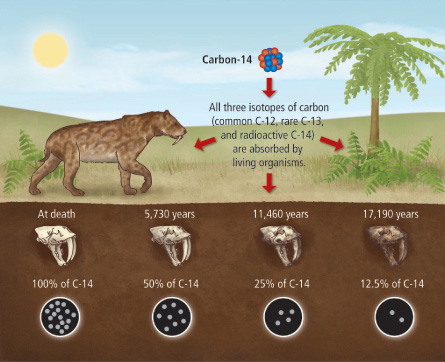Ahmedabad
(Head Office)Address : 506, 3rd EYE THREE (III), Opp. Induben Khakhrawala, Girish Cold Drink Cross Road, CG Road, Navrangpura, Ahmedabad, 380009.
Mobile : 8469231587 / 9586028957
Telephone : 079-40098991
E-mail: dics.upsc@gmail.com

News: Recently, The Allahabad High Court ordered a “scientific survey”, including carbon dating, of a “Shivling” said to have been found at the Gyanvapi mosque complex in Varanasi.
o Carbon dating is a widely-used method to establish the age of organic materials, things that were once living. Living things have carbon in them in various forms. The dating method is based on the fact that Carbon-14 (C-14), an isotope of carbon with an atomic mass of 14, is radioactive, and decays at a well-known rate.
o The most abundant isotope of carbon in the atmosphere is C-12. A very small amount of C-14 is also present. The ratio of C-12 to C-14 in the atmosphere is almost static, and is known.
o Plants get their carbon through photosynthesis; animals get it mainly through food. Because plants and animals get their carbon from the atmosphere, they too acquire C-12 and C-14 in roughly the same proportion as is available in the atmosphere.
o When they die, their interactions with the atmosphere stop. While C-12 is stable, the radioactive C-14 reduces to one half of itself in about 5,730 years — known as its ‘half-life’.
o The changing ratio of C-12 to C-14 in the remains of a plant or animal after it dies can be measured and can be used to deduce the approximate time when the organism died.
o Carbon dating cannot be applied in all circumstances. It cannot be used to determine the age of non-living things like rocks.
o For determining the age of inanimate things, instead of carbon, decays of other radioactive elements that might be present in the material become the basis for the dating method. These are known as Radiometric Dating Methods.
o Two commonly employed methods for dating rocks are potassium-argon dating and uranium-thorium-lead dating.
o For example, the radioactive isotope of potassium decays into argon, and their ratios can give a clue about the age of rocks.
o There are also methods to determine how long an object has remained exposed to sunlight. These apply different techniques, but are again based on radioactive decays and are particularly useful in studying buried objects or changes in topology.
o The most common of these is called cosmogenic nuclide dating, or CRN, and is regularly applied to study the age of ice cores in polar regions.
o However, in the current case as the structure cannot be uprooted or disrupted, as per orders of the Supreme Court, so methods like looking for trapped organic material beneath it might not be feasible.
Source – The Indian Express

Address : 506, 3rd EYE THREE (III), Opp. Induben Khakhrawala, Girish Cold Drink Cross Road, CG Road, Navrangpura, Ahmedabad, 380009.
Mobile : 8469231587 / 9586028957
Telephone : 079-40098991
E-mail: dics.upsc@gmail.com
Address: A-306, The Landmark, Urjanagar-1, Opp. Spicy Street, Kudasan – Por Road, Kudasan, Gandhinagar – 382421
Mobile : 9723832444 / 9723932444
E-mail: dics.gnagar@gmail.com
Address: 2nd Floor, 9 Shivali Society, L&T Circle, opp. Ratri Bazar, Karelibaugh, Vadodara, 390018
Mobile : 9725692037 / 9725692054
E-mail: dics.vadodara@gmail.com
Address: 403, Raj Victoria, Opp. Pal Walkway, Near Galaxy Circle, Pal, Surat-394510
Mobile : 8401031583 / 8401031587
E-mail: dics.surat@gmail.com
Address: 303,305 K 158 Complex Above Magson, Sindhubhavan Road Ahmedabad-380059
Mobile : 9974751177 / 8469231587
E-mail: dicssbr@gmail.com
Address: 57/17, 2nd Floor, Old Rajinder Nagar Market, Bada Bazaar Marg, Delhi-60
Mobile : 9104830862 / 9104830865
E-mail: dics.newdelhi@gmail.com